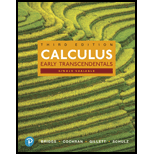
Combining power series Use the geometric series
to find the power series representation for the following functions (centered at 0). Give the interval of convergence of the new series.
32.
Trending nowThis is a popular solution!

Chapter 11 Solutions
Calculus, Single Variable: Early Transcendentals (3rd Edition)
- Use the power series 00 1 E(-1)"x". > |x| < 1 1+ x n = 0 to find a power series for the function, centered at 0. -2 1. 1 h(x) = + x? - 1 1 +X 1- x h(x) = E n = 0 Determine the interval of convergence. (Enter your answer using interval notation.)arrow_forwardFind the sum of the series It will be a function of the variable x. ∞ x8n x Σ(-1)". n=0 n!arrow_forwardhow do i solve the attached calculus question?arrow_forward
- Explain how to use the geometric series g(x) = 6 1+x function Select one: a. O b. C. replace x with replace x with replace x with 1 1-x n=0 and divide the series by 6 6 (-x) 6 = d. replace x with (-x) and divide the series by 6 e. replace x with (-x) and multiply the series by 6 x Σx". x <1 to find the series for thearrow_forwardC and Darrow_forward45-50. Binomial series a. Find the first four nonzero terms of the binomial series centered at 0 for the given function. b. Use the first four terms of the series to approximate the given quantity. 46. f(x) = √1+x; approximate √/1.06.arrow_forward
- ∞0 11. Discuss the convergence of the series 1/n², p > 0.arrow_forward1,: ? Credit Union National-Association- Using series, evaluate the inteġral I = [ f(x) dx, where f is the function whose graph is shown below. Hints: (i) The area of a triangle is (basex height). (ii) Compute the areas A1, A2, etc.., find a pattern and sum them A4 A3 A2 y=f(x) A1 0.. 1 72 2 X2 1. Apr/2021 5:00 Jain 5:00-6:10 PDT Mencses wided to Jonathaarrow_forward(-1)"n(z-4)" 3. Find the radius of convergence and interval of convergence for the power series n-1 2narrow_forward
- (Review) Determine whether the series E(-1)n+1 n3+5 Converges absolutely, converges conditionally, or diverges. n=1 a. converges absolutely b. converges conditionally c. diverges d. cannot be determined Let f(x) = 1 Which of the following are true? (2 marks) 1+2x² a) f(x) = E(-1)" 2"x²n if – 1< x < 1. n=0 b) f(x) = E(-1)" 2"x²n if – < x < %: n=0 c) T3,0(x) = 1 – 2x2 . d) f"(0) = -2³ · 3!. e) ſi H da 1+2x² E (-1)" 2"[2²n – 1). n=0arrow_forwardTrue or Flasearrow_forward(-3)-1 PL The Maclaurin series for a function f' is given by (-3) --- 71 converges to f(x) for x < R, where R is the radius of convergence of the Maclaurin series. ... and (b) Write the first four nonzero terms of the Maclaurin series for f', the derivative off. Express as a rational function for x < R.arrow_forward
 Calculus: Early TranscendentalsCalculusISBN:9781285741550Author:James StewartPublisher:Cengage Learning
Calculus: Early TranscendentalsCalculusISBN:9781285741550Author:James StewartPublisher:Cengage Learning Thomas' Calculus (14th Edition)CalculusISBN:9780134438986Author:Joel R. Hass, Christopher E. Heil, Maurice D. WeirPublisher:PEARSON
Thomas' Calculus (14th Edition)CalculusISBN:9780134438986Author:Joel R. Hass, Christopher E. Heil, Maurice D. WeirPublisher:PEARSON Calculus: Early Transcendentals (3rd Edition)CalculusISBN:9780134763644Author:William L. Briggs, Lyle Cochran, Bernard Gillett, Eric SchulzPublisher:PEARSON
Calculus: Early Transcendentals (3rd Edition)CalculusISBN:9780134763644Author:William L. Briggs, Lyle Cochran, Bernard Gillett, Eric SchulzPublisher:PEARSON Calculus: Early TranscendentalsCalculusISBN:9781319050740Author:Jon Rogawski, Colin Adams, Robert FranzosaPublisher:W. H. Freeman
Calculus: Early TranscendentalsCalculusISBN:9781319050740Author:Jon Rogawski, Colin Adams, Robert FranzosaPublisher:W. H. Freeman
 Calculus: Early Transcendental FunctionsCalculusISBN:9781337552516Author:Ron Larson, Bruce H. EdwardsPublisher:Cengage Learning
Calculus: Early Transcendental FunctionsCalculusISBN:9781337552516Author:Ron Larson, Bruce H. EdwardsPublisher:Cengage Learning





